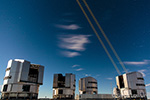The earlier post describing the distance of the imager was clearly INACCUATEChris Peterson wrote:Assuming that the earlier post describing the image was accurate, the distance of the imager was more like 50 meters from the telescope, which would create a 2 arcmin parallax shift, which can be compared with the 10 arcmin diagonal length of the square.neufer wrote:
In any event, so far as the telescope is concerned, the target is dead center for both the four separate vanishing points as well as the wider square of the four sodium "artificial guidestars." However, I estimate that the APOD picture was taken a good 400m to the side of the telescope causing the sodium "artificial guidestars" to shift by about a quarter of a degree (from the vanishing point square).
The distance of the imager was at least 400 meters from the telescope,
- ... and even further than 400 meters if:
- 1) M43 was not near zenith
2) the sodium layer was thinner than 15 km.
- 1) M43 was not near zenith
And I can easily tell that the APOD telescope was pointing at M43 not M42.Chris Peterson wrote:People 100 meters away can easily tell where such a telescope is pointing.neufer wrote:Try moving 40m away.Chris Peterson wrote:
BTW, it is common these days to use a green laser pointer instead of a finder scope in aiming small telescopes. The laser is mounted to the telescope tube, coaxial with its optical axis. Where you see the laser beam end in the sky is where the scope is pointed, and that doesn't change if you move away from the scope.
